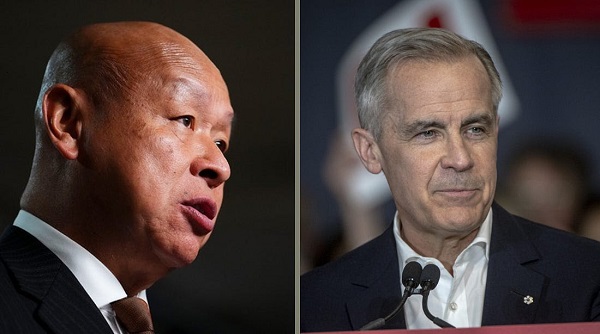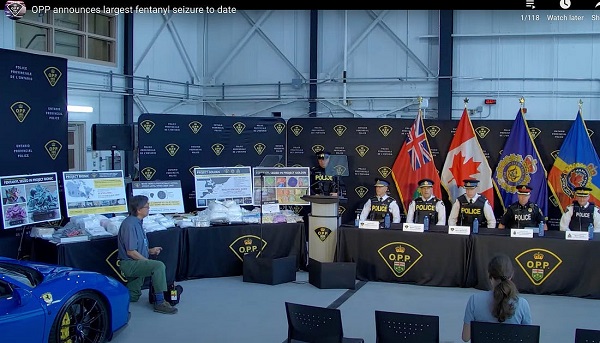Uncategorized
After mosque attacks, New Zealand bans ‘military-style’ guns

CHRISTCHURCH, New Zealand — New Zealand Prime Minister Jacinda Ardern on Thursday announced a ban of “military-style” semi-automatic firearms and high-capacity magazines like those used in the shootings at Christchurch mosques last week.
Ardern said a sales ban was effective immediately to prevent stockpiling and would be followed by a complete ban on the weapons after new laws were rushed through.
She said people could hand over their guns under an amnesty while officials develop a formal buyback scheme, which could cost up to 200 million New Zealand dollars ($140 million).
The man charged in the mosque attacks had purchased his weapons legally using a standard firearms license and enhanced their capacity by using 30-round magazines “done easily through a simple online purchase,” Ardern said.
“Every semi-automatic weapon used in the terrorist attack on Friday will be banned,” she said.
The ban includes any semi-automatic guns or shotguns that are capable of being used with a detachable magazine that holds more than five rounds. It also extends to accessories used to convert guns into what the government called “military-style” weapons.
It does not include semi-automatic .22
The government said the police and military would be exempt as would businesses carrying out professional pest control. Access for international shooting competitions would also be considered.
There are nearly 250,000 licensed gun owners in New Zealand, which has a population of 5 million people. Officials estimate there are 1.5 million guns in the country.
Ardern’s announcement comes as authorities announced that all 50 bodies from the attacks were formally identified and families were burying their loved ones.
At least nine funerals took place Thursday, including for a teenager, a youth soccer coach and a Muslim convert who loved connecting with other women at the mosque.
After Ardern’s announcement, one of New Zealand’s largest gun retailers, Hunting & Fishing New Zealand, reiterated its support of “any government measure to permanently ban such weapons.”
“While we have sold them in the past to a small number of customers, last week’s events have forced a reconsideration that has led us to believe such weapons of war have no place in our business — or our country,” chief executive Darren Jacobs said in a statement.
Regardless of the ban, the company would no longer stock any assault-style firearms of any category and would also stop selling firearms online, he said.
Although the exact weapons used in the mosque attacks have not been made public, images of them posted by the gunman show at least one of them to be a semi-automatic rifle similar to an AR-15 that is widely available in New Zealand. Semi-automatic refers to a firearm’s ability to self-load, not only firing a bullet with each trigger pull, but also reloading and making the firearm capable of firing again.
The military versions most resembling the AR-15 rifle are the M16 and M4 carbines, which can fire in semi-automatic mode, three-round burst mode or fully automatic mode.
Many different types of firearms, from pistols to rifles and shotguns, can be semi-automatic. Semi-automatic rifles like the AR-15 can often be modified with aftermarket parts, or accessories, to fire in fully automatic mode and instructions can often be found on the internet.
Polly Collins, 64, of Christchurch, was thrilled to hear of Ardern’s announcement as she visited a flower memorial for the victims.
“The prime minister is amazing,” she said. “It’s not like in America, where they have all these things and then they go ‘Oh yeah, we’ll deal with the gun laws,’ and nothing’s done.”
At the cemetery, solemn farewells continued for Cashmere High School student Sayyad Ahmad Milne, 14, who was known as an outgoing boy and the school’s futsal goalkeeper. Tariq Rashid Omar, 24, graduated from the same school, played soccer in the summer and was a beloved coach of several youth teams and was also buried Thursday.
In a post on Facebook, Christchurch United Football Club Academy Director Colin Williamson described Omar as “a beautiful human being with a tremendous heart and love for coaching.”
Linda Armstrong, 64, a third-generation New Zealander who converted to Islam in her 50s, was also buried, as were Hussein Mohamed Khalil Moustafa, 70, Matiullah Safi, 55, and Haji Mohammed Daoud Nabi.
Police Commissioner Mike Bush said all 50 victims had been identified as of Thursday and their families were being notified. Investigators also were trying to conclude their work at the two mosques.
“We are working to restore them in a way that is absolutely respectful,” he said.
An Australian white supremacist, Brenton Harrison Tarrant, was arrested by police who ran him off the road while he was believed to be on his way to a third target. He had livestreamed the attack on Facebook and said in his manifesto he planned to attack three mosques.
Also on Thursday, police said they’d inadvertently charged Tarrant with the murder of a person who is still alive.
Police said in a statement they had apologized to the person incorrectly named on the document and would change the charge sheet. They said the charge remains valid, so there was no chance the suspect would be released as a result of the error.
Police did not offer further details of what went wrong or make anybody available for an interview.
The name of the person on the charging sheet has been suppressed by court order. Officials said more charges against Tarrant would follow.
Tarrant, 28, is next scheduled to appear in court on April 5, and Bush said investigations into him were continuing. Police have said they are certain Tarrant was the only gunman but are still investigating whether he had support.
Meanwhile, preparations were underway for a massive Friday prayer service to be led by the imam of one of the mosques where worshippers were killed.
Imam Gamal Fouda said he is expecting 3,000 to 4,000 people at the prayer service, including many who have come from abroad.
Workers at the Al Noor mosque have been trying feverishly to repair the destruction, Fouda said.
“They will bury the carpet,” he said. “Because it is full of blood, and it’s contaminated.”
Fouda said that he expects the mosque to be ready to open again by next week and that some skilled workers had offered their services for free.
___
Associated Press writer Kristen Gelineau also contributed to this report.
Juliet Williams And Nick Perry, The Associated Press
Uncategorized
Kananaskis G7 meeting the right setting for U.S. and Canada to reassert energy ties


Energy security, resilience and affordability have long been protected by a continentally integrated energy sector.
The G7 summit in Kananaskis, Alberta, offers a key platform to reassert how North American energy cooperation has made the U.S. and Canada stronger, according to a joint statement from The Heritage Foundation, the foremost American conservative think tank, and MEI, a pan-Canadian research and educational policy organization.
“Energy cooperation between Canada, Mexico and the United States is vital for the Western World’s energy security,” says Diana Furchtgott-Roth, director of the Center for Energy, Climate and Environment and the Herbert and Joyce Morgan Fellow at the Heritage Foundation, and one of America’s most prominent energy experts. “Both President Trump and Prime Minister Carney share energy as a key priority for their respective administrations.
She added, “The G7 should embrace energy abundance by cooperating and committing to a rapid expansion of energy infrastructure. Members should commit to streamlined permitting, including a one-stop shop permitting and environmental review process, to unleash the capital investment necessary to make energy abundance a reality.”
North America’s energy industry is continentally integrated, benefitting from a blend of U.S. light crude oil and Mexican and Canadian heavy crude oil that keeps the continent’s refineries running smoothly.
Each day, Canada exports 2.8 million barrels of oil to the United States.
These get refined into gasoline, diesel and other higher value-added products that furnish the U.S. market with reliable and affordable energy, as well as exported to other countries, including some 780,000 barrels per day of finished products that get exported to Canada and 1.08 million barrels per day to Mexico.
A similar situation occurs with natural gas, where Canada ships 8.7 billion cubic feet of natural gas per day to the United States through a continental network of pipelines.
This gets consumed by U.S. households, as well as transformed into liquefied natural gas products, of which the United States exports 11.5 billion cubic feet per day, mostly from ports in Louisiana, Texas and Maryland.
“The abundance and complementarity of Canada and the United States’ energy resources have made both nations more prosperous and more secure in their supply,” says Daniel Dufort, president and CEO of the MEI. “Both countries stand to reduce dependence on Chinese and Russian energy by expanding their pipeline networks – the United States to the East and Canada to the West – to supply their European and Asian allies in an increasingly turbulent world.”
Under this scenario, Europe would buy more high-value light oil from the U.S., whose domestic needs would be back-stopped by lower-priced heavy oil imports from Canada, whereas Asia would consume more LNG from Canada, diminishing China and Russia’s economic and strategic leverage over it.
* * *
The MEI is an independent public policy think tank with offices in Montreal, Ottawa, and Calgary. Through its publications, media appearances, and advisory services to policymakers, the MEI stimulates public policy debate and reforms based on sound economics and entrepreneurship.
As the nation’s largest, most broadly supported conservative research and educational institution, The Heritage Foundation has been leading the American conservative movement since our founding in 1973. The Heritage Foundation reaches more than 10 million members, advocates, and concerned Americans every day with information on critical issues facing America.
Uncategorized
Poilievre on 2025 Election Interference – Carney sill hasn’t fired Liberal MP in Chinese election interference scandal

From Conservative Party Communications
“Yes. He must be disqualified. I find it incredible that Mark Carney would allow someone to run for his party that called for a Canadian citizen to be handed over to a foreign government on a bounty, a foreign government that would almost certainly execute that Canadian citizen.
“Think about that for a second. We have a Liberal MP saying that a Canadian citizen should be handed over to a foreign dictatorship to get a bounty so that that citizen could be murdered. And Mark Carney says he should stay on as a candidate. What does that say about whether Mark Carney would protect Canadians?
“Mark Carney is deeply conflicted. Just in November, he went to Beijing and secured a quarter-billion-dollar loan for his company from a state-owned Chinese bank. He’s deeply compromised, and he will never stand up for Canada against any foreign regime. It is another reason why Mr. Carney must show us all his assets, all the money he owes, all the money that his companies owe to foreign hostile regimes. And this story might not be entirely the story of the bounty, and a Liberal MP calling for a Canadian to be handed over for execution to a foreign government might not be something that the everyday Canadian can relate to because it’s so outrageous. But I ask you this, if Mark Carney would allow his Liberal MP to make a comment like this, when would he ever protect Canada or Canadians against foreign hostility?
“He has never put Canada first, and that’s why we cannot have a fourth Liberal term. After the Lost Liberal Decade, our country is a playground for foreign interference. Our economy is weaker than ever before. Our people more divided. We need a change to put Canada first with a new government that will stand up for the security and economy of our citizens and take back control of our destiny. Let’s bring it home.”
-

 Health2 days ago
Health2 days agoLast day and last chance to win this dream home! Support the 2025 Red Deer Hospital Lottery before midnight!
-

 Aristotle Foundation2 days ago
Aristotle Foundation2 days agoThe Canadian Medical Association’s inexplicable stance on pediatric gender medicine
-

 conflict2 days ago
conflict2 days ago“Evacuate”: Netanyahu Warns Tehran as Israel Expands Strikes on Iran’s Military Command
-

 Energy2 days ago
Energy2 days agoCould the G7 Summit in Alberta be a historic moment for Canadian energy?
-

 Bruce Dowbiggin2 days ago
Bruce Dowbiggin2 days agoWOKE NBA Stars Seems Natural For CDN Advertisers. Why Won’t They Bite?
-

 Crime2 days ago
Crime2 days agoMinnesota shooter arrested after 48-hour manhunt
-

 Alberta2 days ago
Alberta2 days agoAlberta announces citizens will have to pay for their COVID shots
-

 Uncategorized2 days ago
Uncategorized2 days agoKananaskis G7 meeting the right setting for U.S. and Canada to reassert energy ties





